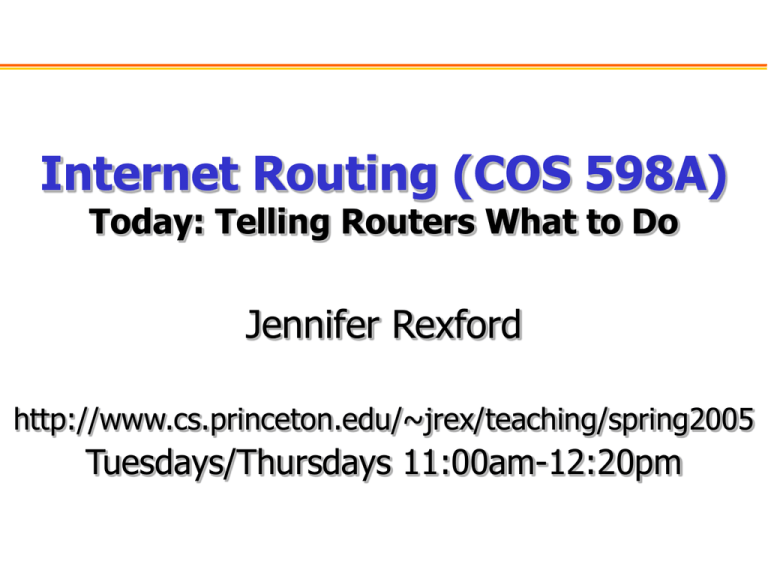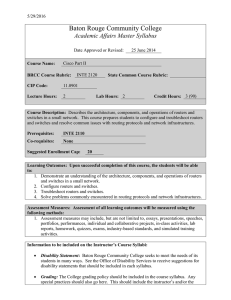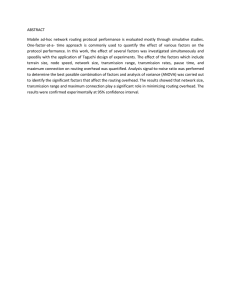Internet Routing (COS 598A) Jennifer Rexford Today: Telling Routers What to Do
advertisement

Internet Routing (COS 598A) Today: Telling Routers What to Do Jennifer Rexford http://www.cs.princeton.edu/~jrex/teaching/spring2005 Tuesdays/Thursdays 11:00am-12:20pm Outline • Drivers for changing the routing architecture – Complexity – Inflexibility • Who wants what – Operators – End users – Researchers • Removing routing from routers – Routing As a Service – Routing Control Platform – Wafer-thin control plane Drivers for Architectural Change • Big problems – Complexity for operators to manage the network – Difficulty for users to get what they want – Challenging for R&D to change the infrastructure • Architectural approaches – Change the division of functionality • Data, control, and management planes – Change the division of responsibility • End users, third parties, and service providers – Add new features in overlay services • Treat today’s network as an unfortunate artifact Internet Architecture • • • • Smart hosts, and a dumb network Network provides best-effort packet delivery All other services implemented on hosts Keep most state at the edges Edge IP Network IP Edge But, how should we partition function vertically? Today: Inside a Single Network Shell scripts Management Plane • Figure out what is Planning tools Databases happening in network Configs SNMP netflow modems • Decide how to change it OSPF Control Plane Link • Multiple routing processes Routing OSPF metrics on each router policies BGP • Each router with different configuration program OSPF OSPF • Many control knobs: link BGP BGP FIB weights, access lists, policy FIB Traffic Engin. Data Plane FIB • Packet handling by routers Packet • Forwarding, filtering, queuing filters No State in the Network? Yeah, Right… • Dynamic state – Routing tables – Forwarding tables • Configuration state – Access control lists – Link weights – Routing policies • Hard-wired state – Default values of timers – Path-computation algorithms Lots of state, updated in a distributed, uncoordinated way How Did We Get in This Mess? • Initial IP architecture – Bundled packet handling and control logic – Distributed the functions across routers – Didn’t fully anticipate the need for management • Rapid growth in features – Sudden popularity and growth of the Internet – Increasing demands for new functionality – Incremental extensions to protocols & routers • Challenges of distributed algorithms – Some tasks are hard to do in a distributed fashion Who Wants What? Network Operators • Network-wide views – Network topology (e.g., routers, links) – Mapping to lower-level equipment – Traffic matrix • Network-level objectives – Load balancing – Survivability – Reachability – Security • Direct control – Explicit configuration of data-plane mechanisms End Users • Good, predictable end-to-end performance – Reachability – Low end-to-end delay – High end-to-end throughput – High reliability • Flexibility to balance trade-offs – Selecting the provider, or end-to-end path – Good performance given a financial constraint – Minimum cost given a performance constraint – Performance guarantees for subset of traffic Researchers • Learn from today’s networks – Measuring and analyzing the Internet – Representative models of traffic, topology, etc. • Clean-slate designs – Move away from today’s artifacts – Propose new architectures, protocols, algorithms • Opportunities to experiment – Collect and analyze measurement data – Evaluate ideas in simulators and testbeds • Plausible deployment paths – Possibility of getting from here to there Removing Routing from Routers Proposals Ask: What Should Routers Do? • Forward packets: yes – Must be done at high speed – … in line-card hardware on fast routers – So, needs to be done on the routers • Compute routes: no – Hard to do in a distribution fashion – Difficult to make load-sensitive routing stable – Lacking complete information for good decisions – Not flexible enough for end users – Difficult to extend over time Routing As a Service • Goal: third parties pick end-to-end paths for clients to satisfy diverse user objectives • Forwarding infrastructure – Basic routing (e.g., default routing) – Primitives for inserting routes • Route selector – Aggregates network information – Selects routes on behalf of clients – Competes with other selectors for customers • End host – Queries route selector to set up paths Analogy to Transportation Networks From Karthik Lakshminarayanan’s slides Multiple route providers Multiple route metrics Time taken Distance Routing Control Platform • Goal: Move beyond today’s artifacts, while remaining compatible with the legacy routers • Incentive compatibility: phased evolution – Intelligent route reflector in a single AS – Learning eBGP routes directly from neighbor ASes – Interdomain routing between RCPs • Backwards compatibility: internal BGP eBGP Inter-AS Protocol –eBGP Using answers to the routers RCPiBGP to “push”RCP RCP iBGP – No need RCPat all RCPto change the legacy routers iBGP iBGP – Keep message format and change decision AS 1 AS 2 AS 3 rules Physical peering Wafer-Thin Control Plane • Goal: Refactor the data, control, and management planes from scratch • Management plane Decision plane – Operates on network-wide view and objectives – Directly controls the data plane in real time • Control plane Discovery plane – Responsible for providing the network-wide view – Topology discovery, traffic measurement, etc. • Data plane – Queues, filters, and forwards data packets – Accepts direct instruction from the decision plane Simple routers that have no control-plane configuration How Does This Differ From Overlays • Overlays: circumventing the underlay – Host nodes throughout the network – Logical links between the host nodes – Active probes to observe the performance – Direct packets through good intermediate nodes • Routing services: controlling the underlay – Servers collect data directly from the routers – Servers compute forwarding tables for the routers – Data packets do not go through the servers – Like an overlay for managing the underlay Maybe some combination of the two makes sense? Discussion Feasibility • Fast reaction to failures – Routers are closer to the failures – Can a service react quickly enough? • Scalability with network size – State and computation grow with the topology – Can a service manage a large network? • Reliability? – Service is now a point of failure – Is simple replication enough? • Security? – Service is now a natural point of attack – Easier (or harder) to protect than the routers? Collecting Measurement Data • All three proposals make measurement a firstorder part of running the network • Routers have only two jobs – Forward packets – Collect measurement data • What measurements? – Topology discovery – Traffic demands – Performance statistics – …? Algorithms for Computing Routes • Selecting routes should be easier – Complete view of network topology and traffic – Possibility of using centralized algorithms – Direct control over forwarding tables • …but what algorithms to use? – Still need a separation of timescale, but how? • Fast reaction to topological changes • Semi-offline optimization of routing • … and how to compute end-to-end paths? – Policy-based path vector protocol? – Publish/subscribe system? – Something else? Solving Real Problems? • Customer load-balancing – Trading off load, performance, and cost – Controlling inbound and outbound traffic – Avoiding small subnets and BGP tweaks • Preventing overloading router resources – Minimum-sized forwarding table per router – Minimum stretch while obeying memory limits • Flexible end-to-end path selection – Satisfy the goals of end users and providers – Handle pricing/economics in the right way Other Thoughts? Next Time: Routing Software • No class next week – Work on course projects – Written report due May 10 – Class presentations on May 16 (?) • Two papers (NSDI’05) for April 19 class – “Designing Extensible IP Router Software” – “Design and Implementation of a Routing Control Platform” • Review just of the first paper • Optional: pointers to OpenBGPd and Quagga




